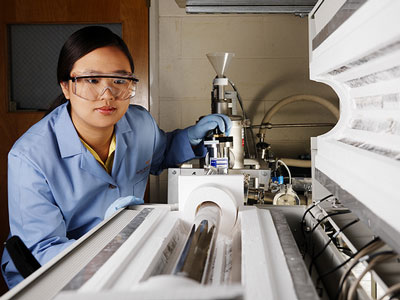| Posted: July 14, 2010 |
Adding a bit of graphene to battery materials could dramatically cut the time it takes to recharge electronics |
|
(Nanowerk News) New battery materials developed by the Department of Energy's Pacific Northwest National Laboratory and Vorbeck Materials Corp. of Jessup, Md., could enable electric vehicles, power tools and even cell phones to recharge in minutes rather than hours.
|
 |
| A PNNL researcher prepares and tests lithium ion batteries and lithium/air batteries for vehicle and other mobile applications.
|
|
In collaboration with Vorbeck and researcher Ilhan Aksay at Princeton University, PNNL has demonstrated that small quantities of graphene — an ultra-thin sheet of carbon atoms — can dramatically improve the power and cycling stability of lithium-ion batteries, while maintaining high energy storage capacity. The pioneering work could lead to the development of batteries that store larger amounts of energy and recharge quickly.
|
|
Today, a typical cell phone battery takes between two and five hours to fully recharge. Researchers think using new battery materials with graphene could cut recharge time to less than 10 minutes.
|
|
Battelle, which operates PNNL for DOE, entered into a Cooperative Research and Development Agreement with Vorbeck for use of its unique graphene material, Vor-xTM, in battery materials synthesis research. Click here to read the announcement from Vorbeck.
|
|
This research is made possible the by the Department of Energy's Office of Energy Efficiency and Renewable Energy's Technology Commercialization Fund.
|

